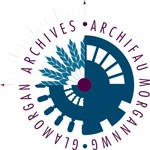The work of auctioneers and chartered surveyors is often associated with housing and land – primarily agricultural. However, as the records held at Glamorgan Archives for Stephenson and Alexander demonstrate, the Cardiff based company handled the sale and letting of just about every manner of property, including a swathe of businesses both commercial and industrial. When the auctioneers advertised the sale of the Naval Steam Coal Colliery in September 1897, it was by no means unusual, given that the company had recently sold an engineering works in Treherbert, a foundry in Caerphilly and a fuel works in Cardiff.

The Naval Colliery drew together three pits Pandy, Nantgwyn and Ely. The pits were to be sold lock, stock and barrel, including …fixed and loose plant machinery, railway sidings, colliery horses and appliances. For those interested in the history of mining in South Wales the lists compiled by the auctioneers provide a treasure trove of information, detailing the equipment used and, in most cases, providing details of the manufacturers. The scale of the enterprise across the three pits is underlined by the inclusion in the sale of 600 railway waggons to transport the coal to the Barry and Cardiff docks, almost 650 miners lamps and 156 horses for underground work.

In addition, the sale details contain a range of background information on the performance and prospects for the pits. This includes the costs of transporting the coal by rail to either the Barry or Cardiff docks and the size and scale of the estimated reserves of coal in the seams mined by the three pits. Recent production figures were also given, with the pits having produced 46,000 tons of coal in the 26 working days in July 1897.
As might be expected, the auctioneers were very upbeat about the prospects for the colliery:
The quantity of unworked Steam Coal in the measures which have been proved under the property is estimated at 28,000,000 tones. This coal is of first quality, is within short distance of port, and can be worked at the rate of over 600,000 tons a year with a relatively small expenditure beyond the purchase money. Such an opportunity of acquiring a really first class Steam Coal Colliery in the Rhondda district, rarely presents itself.
There seemed to be grounds for optimism that the colliery would soon be sold. Just a month before the sale the owners had paid for the men of Naval Colliery and their families to travel by train to Swansea for the annual summer outing, with most heading for the seaside delights of the Mumbles. There was even heady talk of the miners banding together to buy the colliery. Yet the number of cases in the newspapers of fines imposed for the theft of coal confirmed that these were also hard times. The demand for coal in Britain and abroad fluctuated and many pits in this period were on short time.
There was relief in local communities, therefore, when it was announced, in mid-October, that the colliery had been sold to Messrs D A Thomas and Gueret. Despite the best efforts of Stephenson and Alexander, the colliery had failed to make its reserve of £85,000 at auction. No doubt, Thomas and Gueret had acquired the colliery at a significant discount.
Louis Gueret was head of a Cardiff coal exporting firm and went on to be the Chairman of the Naval Colliery Company. D A Thomas was almost certainly David Alfred Thomas, later known as Viscount Rhondda, the son of a family that owned the Cambrian Collieries. In 1908 Naval was merged with Cambrian and two other collieries to form the Cambrian Combine under Thomas’ leadership. As such it became part of a very powerful industrial group. However, in forming larger units Thomas was already anticipating the decline in the demand for coal that would severely damage the industry in the interwar era.
If you are interested in the history of the local collieries and mining communities in South Wales you can access a research guide, Colliery Records for Family Historians, on the website of Glamorgan Archives. In addition, the National Coal Board records held at the Archives have basic information on just about every colliery. Details of the Stephenson & Alexander collection, including the sales prospectus for the Naval Steam Coal Colliery, can be found online, under reference DSA, in the catalogue of the Glamorgan Archives at https://canfod.glamarchives.gov.uk/.
The next article, drawing on the Stephenson and Alexander collection, will look at the grand home in Penarth of one of the directors of the Naval Steam Coal Colliery that was sold just over 12 months after the colliery changed hands.
Tony Peters, Glamorgan Archives Volunteer

Another fascinating piece by the Archive volunteers. Thanks!